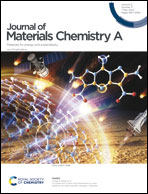First-principles study on a new chloride solid lithium-ion conductor material with high ionic conductivity†
Abstract
Both the exploration of novel structures and the investigation of ion-transport mechanisms are essential in the development of solid-state electrolytes (SEs). We performed high-throughput calculations to screen the structures derived from Na-containing compounds. Through ion substitution, we identified P42/m LiSbCl6 (LSC), which inherits the stability of the original NaSbCl6 (NSC) structure but with improved ion-transport performance. The calculated ion-migration energy barriers in LSC and NSC were 0.16 eV and 0.19 eV, respectively, and the critical role of c-axis ion transport in LSC was thoroughly investigated. The migration barriers for various transport mechanisms in LSC were calculated using the climbing-image nudged elastic band (CI-NEB) method, and the probability density distributions of Li in ab initio molecular dynamics (AIMD) showed that its c-axis direction fast migration is synergistically induced by multiple mechanisms. This synergy arises from cation defects induced by ionic motion in the ab-plane and anionic group motion facilitating Li transport. Based on these findings, we propose that LiSbCl6 should be further studied and could be utilized as a new type of high ionic conductivity chloride electrolyte in all-solid-state batteries (ASSBs).



 Please wait while we load your content...
Please wait while we load your content...